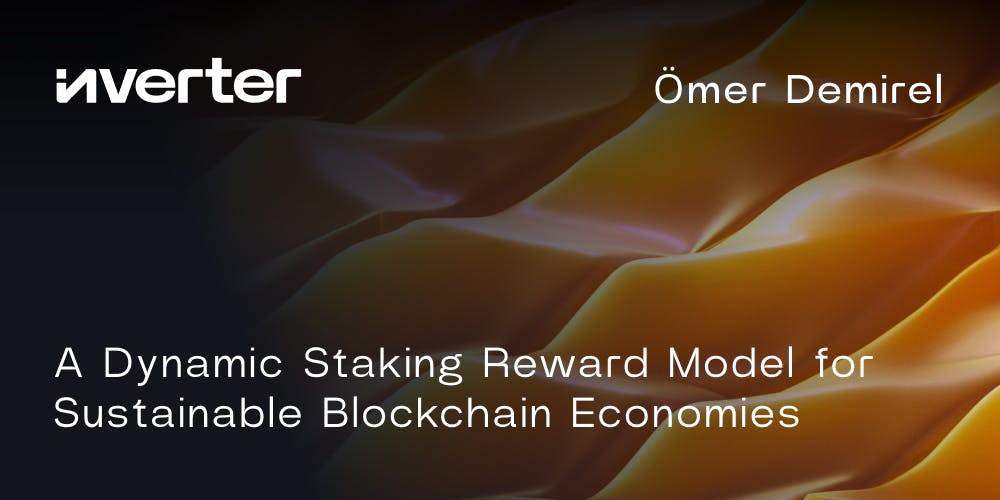
7 min read

With blockchain economies and cryptocurrencies now exceeding $2 trillion in market capitalization, the stakes have never been higher. Managing token supply, controlling inflation, and maintaining stability are critical tasks that need a different approach in decentralized environments, unlike traditional finance, where central authorities play a key role. The challenge is to balance growth, security, and sustainability without relying on centralized control.
Primary Issuance Markets (PIMs) offer a promising solution by providing tools to manage token supply and demand dynamically. PIMs are particularly effective because they enable blockchains to adjust token issuance in real time based on market conditions, external demand, and network requirements. However, for Proof-of-Stake (PoS) blockchains using PIMs, there are two key challenges: staking rewards must be flexible enough to adapt to the network’s changing needs, and these rewards must be closely tied to external data such as market dynamics, KPIs, and governance decisions.
To address these challenges, we propose a dynamic staking reward model that integrates multiple mechanisms for token issuance, including staking rewards, direct minting via a PIM, and governance inputs. This model offers a decentralized solution for economic management within sovereign blockchain ecosystems, incorporating external data into the staking yield curve to ensure cryptoeconomic security and long-term sustainability.
Most decentralized applications typically use bonding curves as Automated Market Makers (AMMs). Recently, bonding curves have been applied to PIMs to govern token price and supply dynamics.
The dynamic staking reward model integrates the bonding curve directly into the staking reward (minting) function. This integration creates a more responsive and adaptive economic model that dynamically adjusts staking rewards based on real-time market conditions and governance inputs and ensures that validator incentives align with the network's overall health.

A highly customizable sigmoid bonding curve opens up a great design space for token economies.
The bonding curve in this model follows a modified sigmoid shape, where the price increases slowly at first, then rapidly, before tapering off. This curve is leveraged within the staking reward function, which adjusts rewards according to token supply, staking behavior, and market demand.
You can interact with this modified sigmoid function here.
The staking reward function R(S, T) integrates the bonding curve as follows:

Where
This minting function is linear concerning the staking ratio (S_staked / S) and the staking duration (T_staked / T_max). This linearity means that rewards increase proportionally as the staking ratio or the duration increases. Such linearity ensures that the reward mechanism is straightforward and predictable, making it easy for validators to understand and anticipate rewards based on their staking behavior.
The parameters ρ and 𝛾 are designed to be dynamic, influenced by network performance metrics (KPIs) and governance decisions:
Combining staking rewards with a PIM influenced by external demand, the proposed model brings significant benefits for managing a token economy. Here is what that means in practical terms:
Flexibility and Adaptability:
Think of this model as a tool that grows and changes along with the project. It offers enticing staking rewards in the early stages to attract participants and strengthen the network. As things progress and the network matures, the model fine-tunes those rewards and adjusts the PIM settings to keep everything balanced and sustainable over the long haul.
Demand-Driven Incentives:
This model links staking rewards directly to the demand for the token. When demand goes up, the PIM responds by adjusting the supply and prices, which then influences the rewards for validators. This means that during high-demand periods, validators get a little extra for helping to keep the network secure — everyone’s incentives are aligned with the overall health of the ecosystem.
Dynamic Supply Management:
The model also monitors the supply side. When there is a lot of demand, the PIM can release more tokens, but it also encourages people to lock up their tokens through staking. This helps balance out the circulating supply. Conversely, when demand drops, the system can pull back on the supply and tweak rewards to ensure the network stays secure without flooding the market.
Enhanced Market Stability:
Stability is key in any economy, and this model helps to keep things steady. Adjusting to what is happening in the broader market, with features like floor price and real-time parameter tweaks, helps smooth out those wild price swings that can scare off investors. This creates a more stable environment, essential for building and maintaining confidence in the token.
Incentive Alignment and Network Security:
One of this model's biggest strengths is aligning incentives across the board. Tying staking rewards to market demand and governance decisions ensures that validators are always motivated to do what is best for the network. Especially during times of high demand, staking becomes even more attractive, which boosts the network’s security and supports the token’s value.
Decentralized Governance:
Flexibility does not just come from the model itself — it is also built into the governance process. The community gets a say in adjusting things based on what is happening in the market and how the network performs. This means that the game's rules can evolve in response to real-world conditions, keeping everything aligned with the broader goals of a blockchain ecosystem.
Scalability and Long-Term Growth:
Finally, the model can be extended with different PIMs and staking reward parameters. Also, it is built to scale. As the network grows and changes, so can the model. It is designed to adapt to increasing complexity and size, making sure that the economic framework remains robust and capable of supporting long-term growth. In other words, it is not just about managing the here and now — it is about setting the stage for sustainable success in the future.
This article introduces an advanced model for staking reward mechanisms for blockchains. It integrates multiple issuance methods, such as staking rewards, direct minting via PIMs, and governance decisions, into a single formulation. By dynamically adjusting rewards based on KPIs and governance decisions, this model provides a flexible and sustainable approach to managing token economies in blockchain ecosystems. It serves as a foundational framework for building more sophisticated token economies that balance growth, stability, and decentralization.
Future work will involve conducting an in-depth analysis of this model through simulations and real-world deployments in collaboration with Inverter to refine it further and validate its effectiveness in blockchain ecosystems.
I would like to thank Ataberk Casur and Alp Ergin for their valuable feedback and comments.
You can find me on Twitter, where I write about crypto-related topics.
Disclaimer: This article is for informational purposes only and should not be considered financial, investment, or technical advice. Always do your own research and consult with a professional before making any financial decisions.